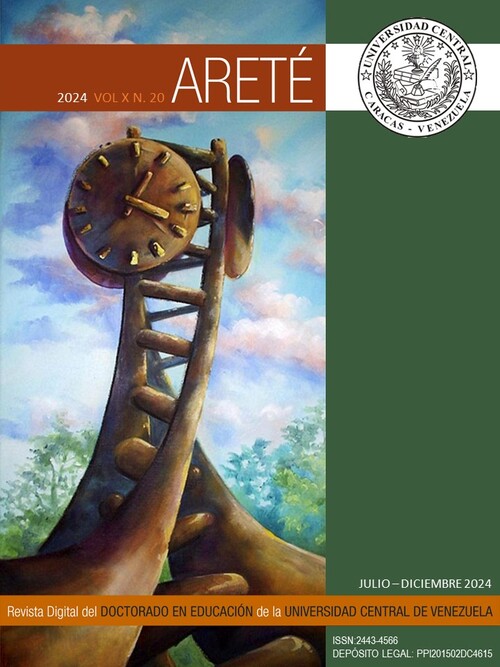Inclusion of second-generation Haitian migrant early childhood in nursery schools
Keywords:
Migration, Early childhood education, Inclusive education, Nursery schoolAbstract
This article examines the process of inclusion of second-generation migrant children in Chilean education, focusing on the strategies used by early childhood educators in nursery schools. A qualitative approach supported by the phenomenological method was used, with the participation of 7 female nursery educators interviewed. The results reveal that the strategies implemented are timely, despite the lack of experiences related to cultural diversity in their daily routine. The strategies include simple gestures, such as welcoming, greeting and creating a welcoming atmosphere, with the purpose of validating the different cultures in the classroom. It is suggested that schools strengthen inclusion by adopting strategies that involve the families of migrant children, recognizing the importance of their dual cultural belonging, and promoting fair and egalitarian education for the whole group of students.
Downloads
References
Aravena, J. y Barrios, A. (2021). Natalidad de la población inmigrante en Chile ¿Un desafío latente? [Tesis de pregrado, Universidad Gabriela Mistral]. Repositorio UGM. https://n9.cl/mof4k
Baleriola, E., Cáceres, P., Jiménez V., F, Lamas, M. y Lalueza, J. (2022). Migración en entornos educativos: La necesidad de un abordaje complejo. Psicoperspectivas, 21(1), 1-5. https://dx.doi.org/10.5027/psicoperspectivas-vol21-issue1-fulltext-2654
Cabrera, N. (2020). Las segundas generaciones de origen extranjero. Universidad de la Laguna. https://riull.ull.es/xmlui/handle/915/22209
Castillo, P. (2021). Inclusión educativa en la formación docente en Chile: tensiones y perspectivas de cambio. Revista de estudios y experiencias en educación, 20(43), 359-375. https://dx.doi.org/10.21703/rexe.20212043castillo19
Constitución Política de la República de Chile, Constitución (1980). Ministerio de Secretaría Nacional de la Presidencia. https://n9.cl/7cqi
Estalayo, P., Miño-Puigcercós, R., Malinverni, P. y Rivera-Vargas, P. (2021). El reto de la inclusión social, más allá de la escuela: Tensiones y carencias de las políticas de integración de niñas y niños migrantes en España. Archivos Analíticos de Políticas Educativas, 29(67), 1-24. https://doi.org/10.14507/epaa.29.6258
Finol, M. Vera, J. (2020). Paradigmas, enfoques y métodos de investigación: análisis teórico. Mundo Recursivo. 3(1), 1-24. https://www.atlantic.edu.ec/ojs/index.php/mundor/article/view/38
Ibáñez, K. (2020). Construcciones identitarias migrantes: identidades en resistencia e identidades estratégicas en niños y niñas haitianos en Santiago en Chile. Revista Innova Educación. 2(2), 260-279. https://revistainnovaeducacion.com/index.php/rie/article/view/78
Ley 20.845 de Inclusión Escolar. (2015). Ministerio de Educación. https://bcn.cl/2f8t4
Matamala, L, y Oyarzo. P. (2022). Estrategias educativas para la inclusión de niñas y niños migrantes haitianos de segunda generación [Tesis pregrado, Universidad de Los Lagos].
Mineduc. (2018). Bases curriculares educación parvularia. Mineduc.
Ministerio de Educación. (2018). Política Nacional de estudiantes Extranjeros 2018-2022. https://n9.cl/yeyc8
Organización Internacional para las Migraciones [OIM]. (2019). Glosario de la OIM sobre migración. https://publications.iom.int/system/files/pdf/iml-34-glossaryes.pdf
Organización Internacional para las Migraciones [OIM]. (2022). Informe sobre las migraciones en el mundo 2022. www.iom.int
Pávez-Soto, I. Galaz-Valderrama, C. Acuña, V. y Colomés, S. (2021). Niñas y niños migrantes en Antofagasta (Chile) experiencias de inclusión social y polivictimización. Zero-a-Seis, 23 (43) https://doi.org/10.5007/1980-4512.2021.e72706
Piza, N., Amaiquema, F, y Beltrán, G. (2019). Métodos y técnicas en la investigación cualitativa. Algunas precisiones necesarias. Conrado, 15(70), 455-459. https://conrado.ucf.edu.cu/index.php/conrado/article/view/1162
Rivera, F. (2020). Situación de la Migración en Chile: datos recientes y tramitación del proyecto de ley de migración. Biblioteca Nacional del Congreso. 31-20. https://n9.cl/arzus
Universidad de La Rioja. (2020). El aula inclusiva, todo un reto de la educación del siglo XXI. UNIR. https://www.unir.net/educacion/revista/aula-inclusiva/
Valdés, A. y Veloso, B. (2019). Inclusión de niños y niñas migrantes y sus familias en el sistema de Educación Parvularia. https://n9.cl/gnauf
Published
How to Cite
Issue
Section
License
Copyright (c) 2024 Ana Milena Mujica-Stach, Luisa Andrea Matamala Llaitul, Patricia Ivette Oyarzo Millaquen

This work is licensed under a Creative Commons Attribution-NonCommercial-ShareAlike 4.0 International License.
This journal provides free, immediate access to its content under the principle of making research freely available to the public, which fosters a greater exchange of global knowledge.
Authors who publish in Areté, Revista Digital del Doctorado en Educación, agree to the following terms:
- Authors retain copyright and grant the journal the right to be the first publication of the work, as well as licensed under a Creative Commons Attribution License that allows others to share the work with an acknowledgement of authorship of the work and initial publication in this journal.
- Authors may separately establish additional agreements for the non-exclusive distribution of the version of the work published in the journal (for example, placing it in an institutional repository or publishing it in a book), with an acknowledgement of its initial publication in this journal and not to be used for commercial purposes.
- The contents and images included in the articles are the responsibility of the author(s). Areté, Revista Digital del Doctorado en Educación, is not responsible for the information included in them.
- Authors agree with the license of use used by the journal, with the self-archiving conditions and with the open access policy.
- Authors are allowed to disseminate electronically (e.g., in institutional repositories or on their own website) the published version of their work, as it favors its earlier circulation and dissemination and thus a possible increase in its citation and reach among the academic community.
- In case of reuse of published works, the existence and specifications of the license of use must be mentioned, as well as the authorship and original source of publication.







